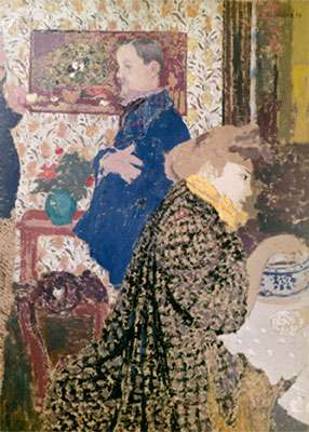Viollard Confidential: Master of Intimism Gets Intense

By Mario Naves Long gone, I hope, are the days when the French painter Édouard Vuillard (1868-1940) was pooh-poohed as being insufficiently radical or, if you prefer, overly bourgeois-as if art steeped in domesticity and comfort somehow precluded pictorial innovation. If Édouard Vuillard: A Painter and His Muses, 1890-1940, an exhibition at the Jewish Museum, doesn't put that avant-gardist trope to bed, nothing will. Actually, make that the first three galleries. In them, we encounter an artist of brooding intensity and startling economy. The standard telling of Intimism underlines how a select group of painters brought Impressionist facture out of the sunlight and into the dining room. Dubbing themselves the Nabis-from the Hebrew and Arabic, meaning "prophets"-these artists looked for inspiration in the color-laden symbolism of Paul Gauguin, the decorative flourishes of Art Nouveau and the flat spaces found in Japanese prints. The resulting imagery spoke (as the novelist André Gide had it) "in a low tone, suitable to confidences." Low, confidential and given to unnerving moments of introspection. New Yorkers familiar with MoMA's "Interior: Mother and Sister of the Artist" (1893), a cornerstone of the permanent collection, know Vuillard wasn't inspired by hearth and home so much as haunted by them. In the best paintings, familial complexity is distilled into images of daunting psychological nuance. (Not for nothing is Proust's name bandied about when speaking of Vuillard's art.) A blunt emphasis on pattern and architecture reinforces a signature strain of emotional pressurization. The curators insist on the theatricality of "Marie Opening the Window" (1893), a portrait of Vuillard's sister, as if its cloistered drama were somehow diminished by it. The organizing conceit of A Painter and His Muses is the role Jewish patronage played in the Parisian art world-a fascinating historical fillip and as good an excuse as any to mount a summer crowd-pleaser. But a truer title might be What's Love Got to Do With It? It was, after all, about the time Vuillard began an extended relationship with his dealer's wife that the art slackened, its gains in scale, vigor and sumptuousness being a lousy recompense for a marked loss in tone, pith and bite. Which is no reason to forego the astringent pleasures shunted toward the front end of this handsomely mounted, if lopsided, exhibition. Édouard Vuillard: A Painter and His Muses, 1890-1940, at the Jewish Museum, 1109 Fifth Ave., until Sept. 23.